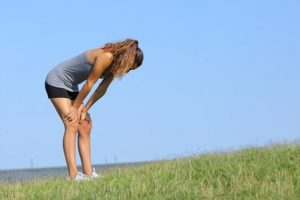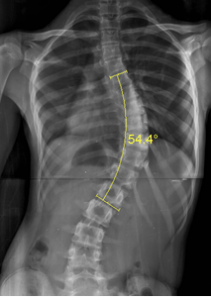Adolescent idiopathic scoliosis (AIS) is by far the most common cause of spinal deviation; it comprises about 80% of all idiopathic vertebral deformities and affects 2%–4% of adolescents.[1] The exact cause of AIS is still being investigated, but scientists generally agree that it is largely determined by genes that are activated by different factors.
When thinking about how we should direct the treatment of scoliosis, we often tend to focus on the well-known potential outcomes of the condition if left untreated- these include physical deformity, disability, pain and discomfort. What we often forgotten is the impact that scoliosis can have in terms of overall health and fitness.
As it stands, research has already confirmed that that scoliosis influences factors like ease of breathing during exercise in a negative way[2] However, brand new research just published in the Journal of Paediatric exercise science now allows us to understand the degree to which cobb angle (the degree of the scoliotic curve) actually has an impact.
The research conducted at the Federal University of São Paulo in 2018, hypothesised that Individuals with scoliosis would have lower exercise tolerance in cardiopulmonary exercise testing (CPET) and in the incremental shuttle walk test (ISWT) – a suggestion which has already been confirmed in preceding studies.[3] Researchers then sought to evaluate the functional capacity (that is to say, the ability of the participants bodies to cope with exercise) in patients with AIS with specific regard to the functional capacity and respiratory variables in patients with different degrees of scoliosis severity.
Participants
The study tested a cross section of participants with varying degrees of scoliosis severity. The group included eighteen patients with mild and moderate scoliosis, 8 patients with severe scoliosis, and 10 adolescents from a control group. Patients were selected from the Orthopaedic Clinic at a local hospital, and they were submitted for radiography to evaluate the Cobb angles prior to the study.
In order to ensure the results were relevant and valid, patients were excluded if they had a previous or current history of heart, lung diseases or neuromuscular disorder, cognitive changes that influenced the understanding of tests, and all those who failed to perform the assessment proposed.
Results
During the ISWT participants are asked to walk between two cones, placed 10 meters apart. Participants aim to match the pace provided by a simple beeping prompt. In this study, each of the partcipants performed the test twice, in order to try to ensure more even results.
Heart rate, blood pressure and fatigue were measured by modified Borg scale before and after the test[4]. The results of the study were conclusive. In the study, patients with AIS definitely performed worse than test subjects without scoliosis. Those with scoliosis found the test harder (more physically taxing) and also displayed a lower level of respiratory function. What’s more, the performance of the individuals with scoliosis was worse in individuals with a more severe cobb angle. Overall, patients with AIS walked shorter distance during the ISWT when compared with adolescents without scoliosis. Patients with AIS > 45° and AIS < 45° walked, respectively, 156 m and 117 m less than the control group.
This study therefore identified that patients with severe scoliosis present worse functional capacity and, perhaps of greatest interest, it draws attention to the fact that even patients with mild and moderate scoliosis already show a significant reduction in functional capacity.
What we learn from this study.
At the UK scoliosis clinic, we are committed to ensuring that all our approach to treating scoliosis is always grounded in the most up to date scientific research available. From the results of the study there are two important take-aways.
In the first instance, the study goes to show the degree to which even a minor case of scoliosis (of the sort which may respond particularly well to bracing) may impact the quality of life and capability of an individual to participate in exercise – both for health-related purposes, and indeed as a social exercise. This is particularly interesting given that the authors of this study also noted a correlation between individuals with scoliosis and low exercise participation rates. Specifically the authors note “Adolescents with scoliosis for some reason are physically unconditioned; some authors believe that this fact is related only to the low adherence of individuals to physical activity, mainly due to the constraint of the disease deformity” . This research therefore goes to underscore the importance of early intervention in dealing with cases of adolescent idiopathic scoliosis.
Secondly, this study (by its methodology) suggest that the ISWT can be a valuable tool for assessing functional capacity in patients with AIS. As a relatively low-cost but widely applicable test, the ISWT may therefore be worth further consideration within the scoliosis treatment community. Dr Irvine is keen to follow up on this insight and will be considering its possible applications within our clinic.
The main source article for this post was:
SARAIVA, BA; et al. “Impact of Scoliosis Severity on Functional Capacity in Patients With Adolescent Idiopathic Scoliosis”. Pediatric Exercise Science. 30, 2, 243-250, May 2018
[1] Weinstein SL, Dolan LA, Cheng JCY, Danielsson A, Morcuende JA. Adolescent idiopathic scoliosis. Lancet. 2008;371:1527–37. PubMed doi:10.1016/S0140-6736 (08)60658-3
[2] Sperandio EF, Alexandre AS, Yi LC, et al. Functional aerobic exercise capacity limitation in adolescent idio- pathic scoliosis. Spine J. 2014;14(10):2366–72. PubMed doi:10.1016/j.spinee.2014.01.041
[3] Sperandio EF, Alexandre AS, Yi LC, et al. Functional aerobic exercise capacity limitation in adolescent idio- pathic scoliosis. Spine J. 2014;14(10):2366–72. PubMed doi:10.1016/j.spinee.2014.01.041
Sperandio EF, Vidotto MC, Alexandre AS, Yi LC, Gotfryd AO, Dourado VZ. Exercise capacity, lung function and chest wall shape in patients with adolescent idiopathic scoliosis. Fisioter Mov. 2015;28(3):563–72. doi:10.1590/0103-5150.028.003.AO15
Barrios C, Pérez-Encinas C, Maruenda JI, Laguía M. Significant ventilatory functional restriction in adoles- cents with mild or moderate scoliosis during maximal exercise tolerance test. Spine. 2005;30(14):1610–5. doi:10.1097/01.brs.0000169447.55556.01
Bas P, Romagnoli M, Gomez-Cabrera MC, et al. Beneficial effects of aerobic training in adolescent patients with mod- erate idiopathic scoliosis. Eur Spine J. 2011;20 Suppl 3: 415–9. PubMed doi:10.1007/s00586-011-1902-7
[4] Hommerding PX, Donadio MV, Paim TF, Marostica PJ. The Borg scale is accurate in children and adolescents older than 9 years with cystic fibrosis. Respir Care. 2010;55(6):729–33. PubMed




